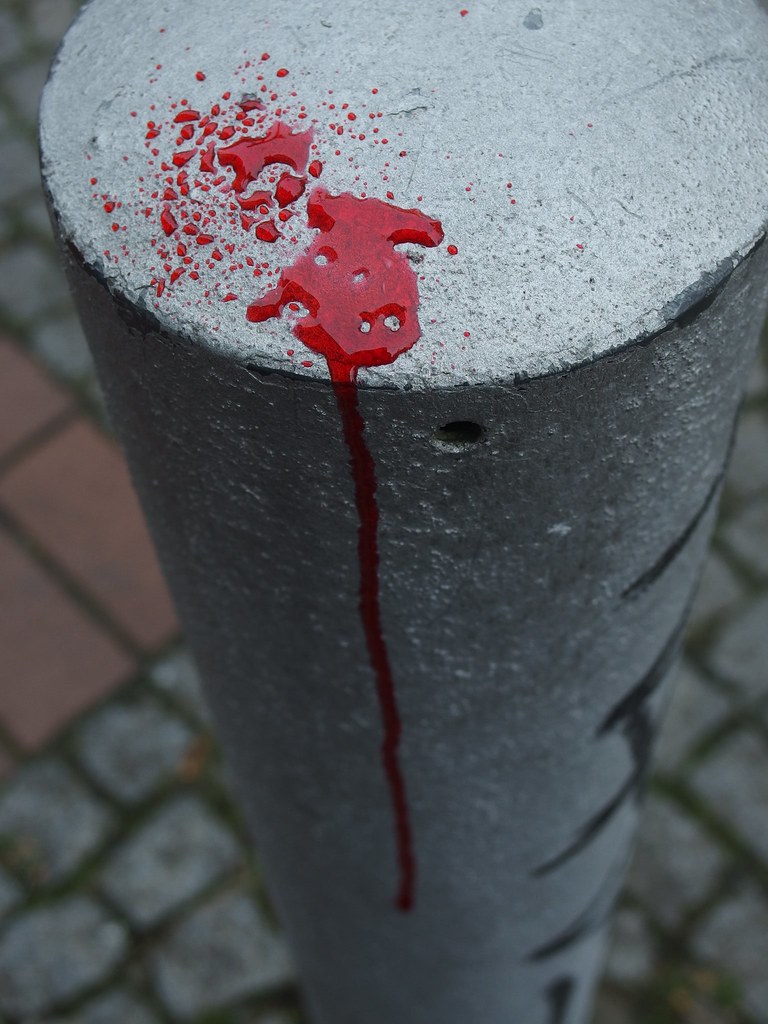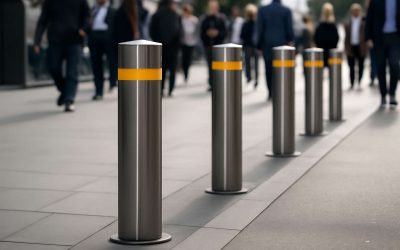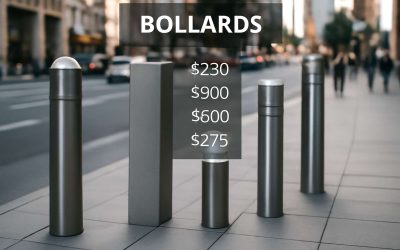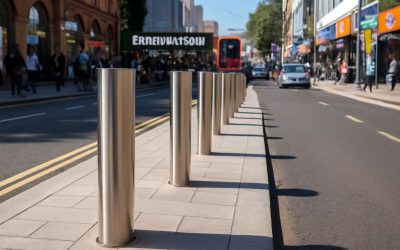Types of Bollards
1.1 – Fixed Bollards
Fixed bollards stand as unwavering sentinels in a world of perpetual change. Unlike their retractable or removable counterparts, they are permanently anchored into the ground, embodying a sense of steadfast protection. Their presence isn’t just functional; it’s almost philosophical, signalling boundaries that are both physical and symbolic. When considering bollards or bollards, the fixed type offers durability and a visual statement of security that cannot be easily compromised.
Available in various materials—steel, concrete, or even stainless steel—fixed bollards are tailored to meet diverse needs. They are particularly suitable for high-traffic areas, where their robustness can withstand the relentless assault of nature and human activity. The choice of material often reflects the environment: urban streets might favour steel for its strength, while decorative settings could opt for more aesthetic finishes.
For those seeking clarity and order, fixed bollards can be customised with reflective coatings, decorative patterns, or even integrated lighting. Their permanence makes them ideal for delineating pedestrian zones or protecting sensitive infrastructure. When durability, security, and visual impact are priorities, fixed bollards remain an enduring solution in the complex dance of urban design and human interaction.
1.2 – Removable Bollards
In a world where flexibility meets fortitude, removable bollards emerge as the chameleons of urban protection. These versatile guardians can be swiftly deployed or withdrawn, offering a dance of control that adapts to the rhythm of daily life. Perfect for events, emergency access, or temporary closures, they serve as a dynamic buffer between chaos and calm.
By design, removable bollards can be installed with ease, often featuring a locking mechanism that ensures they stay in place when needed but vanish when the moment calls for openness. Their presence is less permanent yet equally powerful, providing a sense of security without compromising accessibility. For high-profile areas or city centres where crowds ebb and flow, these bollards are a harmonious blend of form and function.
- Temporary pedestrian zones
- Emergency vehicle access points
- Event-specific security barriers
This adaptability makes them indispensable in modern urban planning, where the landscape of security constantly shifts. Whether crafted from stainless steel or reinforced concrete, removable bollards deliver both resilience and finesse, highlighting their vital role in the intricate ballet of city life.
1.3 – Automatic Bollards
In the relentless pursuit of urban harmony, automatic bollards stand as silent sentinels, seamlessly blending technology with security. These intelligent barriers are designed to respond to an array of stimuli—be it remote control, sensor activation, or programmed schedules—ensuring access is granted or restricted with precision. Their presence is almost invisible until needed, embodying a paradox of subtlety and strength.
What sets automatic bollards apart is their capacity for autonomous operation, reducing the need for manual intervention and enhancing safety in high-security zones or sensitive cityscapes. They can be integrated into a broader security infrastructure, creating a dynamic and adaptive environment that reacts to the ebb and flow of urban life.
Among the types of bollards, some are equipped with:
- Motorised lifting mechanisms for instant deployment
- Sensor-based activation that detects authorised vehicles
- Remote control operation for quick access adjustments
In their quiet efficiency, automatic bollards reveal a new frontier in urban security—one where technology does not overpower human experience but enhances it. Their strategic deployment transforms city streets into adaptable landscapes, balancing the needs of safety with the desire for openness.
1.4 – Decorative vs. Security Bollards
In the realm of urban design, the dichotomy between decorative and security bollards reveals much about our collective priorities—beauty intertwined with safety. Decorative bollards serve as silent ambassadors of aesthetic appeal, transforming mundane city streets into vibrant public spaces. They often feature ornate details, intricate patterns, or colourful finishes, emphasising visual harmony rather than physical protection.
Conversely, security bollards are the unsung heroes of urban resilience. Engineered to withstand impact, they function as formidable barriers against vehicular threats. Their utilitarian design often sacrifices ornamentation for strength, prioritising protection over appearance. Yet, they can be crafted with a surprising elegance that complements the environment, blurring the line between form and function.
Understanding the distinction helps urban planners and security professionals make informed choices, striking a balance that respects both human experience and safety. Sometimes, a single bollard can embody both worlds—offering aesthetic charm while providing vital security. This duality underscores the complex role bollards play in shaping our daily interactions with the cityscape.
Materials Used in Bollards
2.1 – Steel and Metal Bollards
Steel and metal bollards are among the most common choices for urban and commercial environments. Their popularity stems from durability and strength, making them ideal for both security and crowd control. Unlike plastic or timber options, steel bollards can withstand harsh weather conditions and physical impact, ensuring long-lasting protection.
When selecting bollards or bollards, it’s important to consider the specific material properties. Steel, for example, often features a galvanised coating or powder finish, which enhances corrosion resistance and maintains visual appeal over time. Metal bollards also offer versatility in design — from sleek, modern lines to more decorative, ornate styles — to suit various aesthetic and security needs.
In many settings, the choice of materials directly impacts the overall effectiveness of bollards or bollards. For high-security zones, thicker, reinforced steel is essential, while lighter metals may suffice in pedestrian areas. The robustness of steel and metal bollards makes them a preferred option for safeguarding assets and controlling vehicle access without compromising on visual impact or structural integrity.
2.2 – Concrete and Masonry Bollards
When it comes to durability and visual impact, concrete and masonry bollards are unparalleled. Their hefty construction not only provides formidable security but also lends a timeless aesthetic to urban landscapes and commercial spaces. Crafted from dense concrete or specialised masonry, these bollards stand resilient against both environmental elements and physical impact, making them an ideal choice for long-term protection.
In addition to their robustness, concrete bollards can be tailored to various architectural styles through textured finishes or decorative facades. For environments that demand a blend of strength and design, they often feature embedded elements such as metal detailing or coloured aggregates. Here are some common features that make concrete and masonry bollards a versatile choice:
- High resistance to weathering and corrosion
- Customisable in shape, colour, and finish
- Heavyweight construction deters vehicular intrusion
While steel and metal bollards excel in impact resistance, concrete and masonry bollards excel in providing a substantial physical barrier that’s both functional and aesthetically pleasing. Their enduring presence makes them a favourite for delineating pedestrian zones, protecting historical sites, and anchoring landscape designs with a sense of permanence and security.
2.3 – Wooden Bollards
When considering materials for bollards, few evoke the charm and authenticity of wood quite like its timeless appeal. Wooden bollards, often underestimated in the realm of urban infrastructure, bring a warmth and character that concrete and metal sometimes lack. They are crafted from a variety of durable hardwoods and softwoods, each selected to withstand the rigours of outdoor environments—think teak, oak, or treated pine. This choice of material lends itself well to blending seamlessly into natural surroundings or creating a striking contrast in modern settings.
What truly sets wooden bollards apart is their versatility. They can be shaped into sleek, minimalist profiles or adorned with intricate carvings, making them ideal for both decorative and security purposes. Their lightweight nature compared to concrete or masonry bollards allows for easier installation and potential relocation, which is a significant advantage in dynamic urban landscapes.
To enhance longevity, many wooden bollards are treated with preservatives or finished with specialised coatings, protecting against rot, pests, and weathering. Here are some common types of wood used in bollards:
- Treated Pine
- Teak
- Oak
- Cedar
In the grand tapestry of bollards, wood provides a unique blend of aesthetic appeal and functional resilience—proof that sometimes, the oldest materials still hold the greatest charm and utility in modern design.
2.4 – Composite and Modern Materials
As urban landscapes evolve, the demand for innovative and sustainable materials in bollards continues to grow. Modern composites and advanced materials are transforming the way we think about bollards, offering a perfect blend of durability and design flexibility. These innovative solutions not only withstand the rigours of outdoor environments but also introduce an element of versatility that traditional materials sometimes lack.
Composite bollards, often crafted from a mix of recycled plastics and fibres, deliver exceptional resistance to weathering, pests, and corrosion. Their lightweight nature simplifies installation and allows for creative customisation—think vibrant colours or textured finishes that mimic natural materials. Additionally, high-performance polymers are increasingly used in modern bollards, providing a sleek, contemporary aesthetic with minimal maintenance requirements.
Some popular choices include:
- Recycled plastic composites
- High-density polyethylene (HDPE)
- Fibreglass-reinforced polymers
These materials push the boundaries of traditional bollard design, marrying environmental sustainability with resilience. In the ever-changing cityscape, composite and modern materials keep bollards at the forefront of both form and function, ensuring they serve today’s needs while future-proofing urban infrastructure.
Applications of Bollards
3.1 – Urban Street Management
Bollards are the unsung heroes of urban street management, quietly orchestrating the dance between pedestrians, vehicles, and public safety. In bustling city centres, they serve as the frontline defenders against reckless drivers and unpredictable crowds, ensuring that traffic flows smoothly without turning streets into chaotic free-for-alls.
From cordoning off pedestrian zones to creating vehicle exclusion zones around sensitive infrastructure, bollards are remarkably versatile. They can be customised to blend seamlessly with the architectural aesthetic or stand out as bold visual statements. Their application extends beyond mere security; they help delineate bike lanes, protect storefronts, and even serve as art installations that add a touch of personality to otherwise sterile cityscapes.
In the realm of urban street management, an effective deployment of bollards can be categorised into:
- Designated pedestrian-only zones
- Perimeter security around public buildings
- Traffic calming measures in high-density areas
- Protection of outdoor dining and retail spaces
When it comes to implementing bollards for urban street management, the key is striking a balance between safety, accessibility, and aesthetics. After all, a city that looks good and functions well is a city that’s worth walking—and driving—through!
3.2 – Traffic Control and Vehicle Barriers
In the intricate dance of urban mobility, bollards emerge as silent maestros, orchestrating traffic flow and safeguarding vital spaces with unwavering resolve. Their applications in traffic control and vehicle barriers are nothing short of transformative, shaping cityscapes into harmonious environments where safety and efficiency coexist seamlessly. Bollards serve not only as physical boundaries but as strategic tools—designed to guide vehicles, prevent unauthorised access, and protect pedestrians without disrupting the aesthetic rhythm of the street.
When deploying bollards for traffic management, versatility is key. They can be arranged in a variety of configurations, from simple rows delineating lanes to complex formations around sensitive infrastructure. For enhanced security, some bollards are engineered to withstand impact, deterring vehicular threats while maintaining visual elegance. The choice of material—be it steel, concrete, or modern composites—further elevates their functional and visual appeal.
- Implementing bollards as vehicle barriers creates a formidable shield around critical zones, safeguarding public spaces against accidental or malicious vehicular intrusion.
- Strategically placed bollards can calm traffic in densely populated areas, subtly influencing driver behaviour and reducing speed to enhance pedestrian safety.
- In bustling urban centres, they mark clear boundaries that facilitate smooth traffic flow, preventing congestion and chaos.
Ultimately, the artful integration of bollards into urban landscapes transforms city streets into resilient, inviting corridors—where order reigns and safety is woven into the fabric of daily life.
3.3 – Pedestrian Safety and Public Spaces
In bustling cityscapes, where the dance of pedestrians and vehicles often resembles a chaotic ballet, bollards step forward as vigilant choreographers. Their role in safeguarding public spaces is nothing short of essential, transforming once perilous streets into inviting promenades packed with life and comfort. For urban planners and designers alike, bollards are the unsung heroes that create sanctuaries for pedestrians amidst the relentless flow of traffic.
Strategically positioned bollards serve as a gentle yet firm barrier, preventing vehicles from encroaching on pedestrian zones while maintaining an appealing visual harmony. They are vital in establishing clear boundaries, especially in crowded plazas, parks, and transit hubs. When thoughtfully integrated, bollards promote a sense of security—inviting communities to gather, socialize, and enjoy public spaces without trepidation. Truly, these modest fixtures hold the power to redefine how we interact with our urban environments.
- Designated pedestrian zones
- Protection around outdoor dining areas
- Enhancement of public parks and plazas
- Guiding foot traffic along busy thoroughfares
Amidst the architectural elegance and social vibrancy, bollards quietly anchor safety and civility. Their presence fosters a culture of respect—both vehicular and pedestrian—ensuring that public spaces are not just functional but also inviting. An unassuming yet indispensable element, bollards exemplify how subtle infrastructure can elevate the social fabric of urban life.

3.4 – Commercial and Private Property Security
Bollards are the unsung guardians of commercial and private properties. Their primary role is to create a secure perimeter, preventing unauthorised vehicle access while allowing pedestrians to move freely. In bustling retail areas, shopping centres, or private estates, bollards act as a first line of defence against ram-raid attempts or accidental vehicle intrusion.
For high-profile properties, choosing the right bollards can make all the difference. Fixed bollards provide robust, permanent security, while removable options offer flexibility for events or emergencies. Automatic bollards are gaining popularity, enabling quick activation with minimal disruption. These solutions work seamlessly to protect assets and staff, ensuring safety without compromising accessibility.
In many cases, a combination of bollard types is employed. For instance, decorative bollards add aesthetic appeal, blending security with visual charm. Conversely, heavy-duty steel bollards serve as formidable barriers against potential threats. When considering property security, it’s vital to evaluate the level of threat, traffic flow, and aesthetic goals.
- Fixed bollards
- Removable bollards
- Automatic bollards
Each offers distinct advantages tailored to specific needs, making bollards versatile and essential for comprehensive property protection.
Choosing the Right Bollard
4.1 – Factors to Consider (Location, Security Needs)
Choosing the right bollard is an art that balances practicality with aesthetic appeal, and understanding the factors that influence this choice is crucial. Location plays a pivotal role—urban streets demand different bollards than those safeguarding private gardens or corporate plazas. Security needs further influence the selection; high-traffic areas or sensitive sites require bollards designed to withstand impact and prevent vehicle intrusion.
Consider the environment and the level of protection needed. For example, decorative bollards might enhance a historic district’s charm, but high-security areas benefit from reinforced options. Sometimes, the decision hinges on whether the bollard is meant for temporary use or a permanent fixture.
A helpful approach is to evaluate these core considerations:
- Location and aesthetic harmony
- Level of security required
- Frequency of use or need for removal
This careful assessment ensures that each bollard not only meets safety standards but complements the space it protects, transforming utilitarian objects into silent guardians of urban and private realms alike.
4.2 – Design and Aesthetics
Design and aesthetics play a vital role in selecting the right bollards for any setting. A well-chosen bollard not only enhances visual appeal but also communicates the purpose of the space. Whether aiming for a sleek modern look or a historic charm, the style of bollards should complement the environment seamlessly. Think about colour, shape, and material—these details shape the overall feel of the area.
For instance, decorative bollards can add elegance to a pedestrian-friendly plaza, while robust security bollards might blend into a corporate campus’s minimalist design. It’s a balancing act—utility should never be sacrificed for style, yet the right bollards can serve as a subtle design element. Remember, the visual impact influences how people perceive a space. Sometimes, choosing the right bollard involves selecting from a range of options such as:
- Material finish
- Shape and size
- Colour coordination with surroundings
This careful consideration ensures your bollards stand out for their purpose and their aesthetic contribution, creating a space that is both safe and visually engaging.
4.3 – Installation and Maintenance
Choosing the right bollard involves more than just selecting a sturdy fixture; it’s about ensuring longevity and seamless integration into your environment. Installation quality can make or break the effectiveness of bollards, impacting both safety and aesthetics. Proper installation ensures they withstand environmental factors and daily wear, maintaining their function over time. Maintenance, meanwhile, keeps bollards looking sharp and operational, preventing corrosion or damage from frequent use.
Regular upkeep can be straightforward, often involving simple cleaning and inspections. For high-traffic areas, consider a maintenance schedule that includes checking for any structural damage or wear and tear. When selecting bollards, it’s important to think about the material—whether steel, concrete, or composite—as each demands different care routines. This attention to detail guarantees your bollards remain both a visual asset and a reliable barrier for years to come.
4.4 – Cost and Budget Considerations
Budget constraints often dictate the scope and quality of bollards or bollards, making cost and financial planning vital in the selection process. It’s tempting to opt for cheaper options, but investing in durable materials can save money in the long run by reducing maintenance and replacement costs. The initial investment varies widely depending on the type—whether fixed, removable, or automatic bollards—and the material used. For example, steel bollards tend to cost more upfront but offer superior longevity compared to some concrete or composite options.
Understanding the overall cost involves considering installation expenses, ongoing maintenance, and potential security features. To simplify decision-making, some projects benefit from a straightforward cost breakdown, such as:
- Initial purchase price
- Installation costs
- Maintenance and repairs over time
- Potential upgrades or replacements
Balancing these factors against your budget ensures you select bollards or bollards that deliver both value and performance. Cost considerations are not just about saving money but about making strategic choices for safety, aesthetics, and long-term resilience in your environment.
Innovations and Trends in Bollards
5.1 – Smart and Sensor-Enabled Bollards
In a world increasingly driven by technological innovation, bollards are evolving beyond mere physical barriers to become intelligent sentinels of urban landscapes. Smart and sensor-enabled bollards are spearheading a new era where safety, efficiency, and aesthetic harmony intertwine seamlessly. These advanced bollards can detect approaching vehicles or pedestrians, activating or retracting with a whisper of digital command. This dynamic adaptability not only enhances security but also preserves the visual integrity of public spaces—an elegant dance between function and form.
By integrating cutting-edge sensors, these bollards can monitor traffic flow, identify unauthorised access, and even communicate with central security systems in real time. Innovations such as remote control operation and automatic retraction make them indispensable in managing complex urban environments. The future of bollards is not just about physical deterrence but also about creating safer, smarter cities that respond intuitively to their inhabitants’ needs.
5.2 – Eco-Friendly and Sustainable Options
Amid the relentless march of urban development, the quest for sustainability has transformed not only architecture but also the humble bollard. Innovations in eco-friendly and sustainable bollards are ushering in a new era where environmental responsibility and urban safety coalesce. These modern bollards utilise recycled materials, minimising ecological footprints while maintaining durability. Their design often incorporates renewable resources, reflecting a conscious effort to harmonise with nature rather than dominate it.
Moreover, the trend towards green infrastructure has birthed bollards that can be integrated with solar-powered sensors and lighting, reducing reliance on conventional energy sources. Such advancements exemplify a philosophical shift—moving from static barriers to adaptive, environmentally conscious solutions. As cities strive to become more sustainable, these eco-friendly bollards stand at the forefront, embodying both innovation and moral integrity.
Incorporating sustainable practices into bollard manufacturing not only benefits the environment but also resonates deeply with communities seeking to preserve their urban landscapes. The future of bollards is undeniably intertwined with ecological mindfulness, creating smarter, greener cities that thrive in harmony with their surroundings.
5.3 – Integrating Bollards with Urban Tech
As cities evolve into smarter, more interconnected hubs, the integration of urban technology into bollards is transforming public spaces into innovative landscapes of safety and convenience. Modern bollards are no longer static; they harness cutting-edge advancements to enhance urban functionality while maintaining aesthetic integrity. From embedded sensors that detect vehicle movement to seamless connectivity with city infrastructure, these intelligent bollards exemplify a harmonious blend of form and function.
One of the most exciting trends is the deployment of sensor-enabled bollards that can monitor traffic flow, detect unauthorised access, or even relay real-time data to city management systems. This technological synergy not only heightens security but also optimises traffic control, creating smoother, safer streets. Additionally, some bollards now feature integrated cameras and RFID readers, facilitating advanced security protocols without compromising visual appeal.
Incorporating these innovations involves a strategic understanding of urban needs. For instance, prioritising bollards that can be remotely controlled or automatically retract in response to specific triggers ensures a dynamic response to changing circumstances. As a result, these tech-infused bollards epitomise the shift towards adaptive and intelligent urban infrastructure, elevating the everyday experience while safeguarding our shared spaces.
5.4 – Future Outlook for Bollard Design
As cities embrace a future where technology and infrastructure intertwine like threads in a tapestry, bollards are poised to become even more dynamic. The horizon of bollard design promises innovations that blend function with elegance, transforming public spaces into hubs of safety, adaptability, and aesthetic allure. Imagine bollards that not only demarcate boundaries but also actively communicate with urban systems—an enchanting dance of form and digital intelligence.
Emerging trends hint at a future where bollards are smarter and more responsive than ever before. From sensor-embedded variants capable of monitoring traffic flow to retractable models that respond automatically to security alerts, the landscape of bollards is shifting dramatically. These advancements are driven by a desire to craft cities that are not only safer but also more intuitive and sustainable. A list of promising innovations includes:
- Integration with IoT networks for real-time data exchange
- Adaptive safety features that respond to environmental cues
- Enhanced aesthetic options, combining technology with artistry
Looking ahead, the future of bollard design is illuminated by a blend of eco-conscious materials and sophisticated engineering. As urban environments seek to reduce their carbon footprint, biodegradable and recycled materials are gaining prominence in bollard manufacturing. Simultaneously, modular designs are emerging, allowing cities to tailor bollards to specific needs—be it for traffic management, security, or visual harmony. The evolving landscape of bollards hints at a world where these humble fixtures are no longer static barriers but vital, intelligent sentinels of urban life.



0 Comments